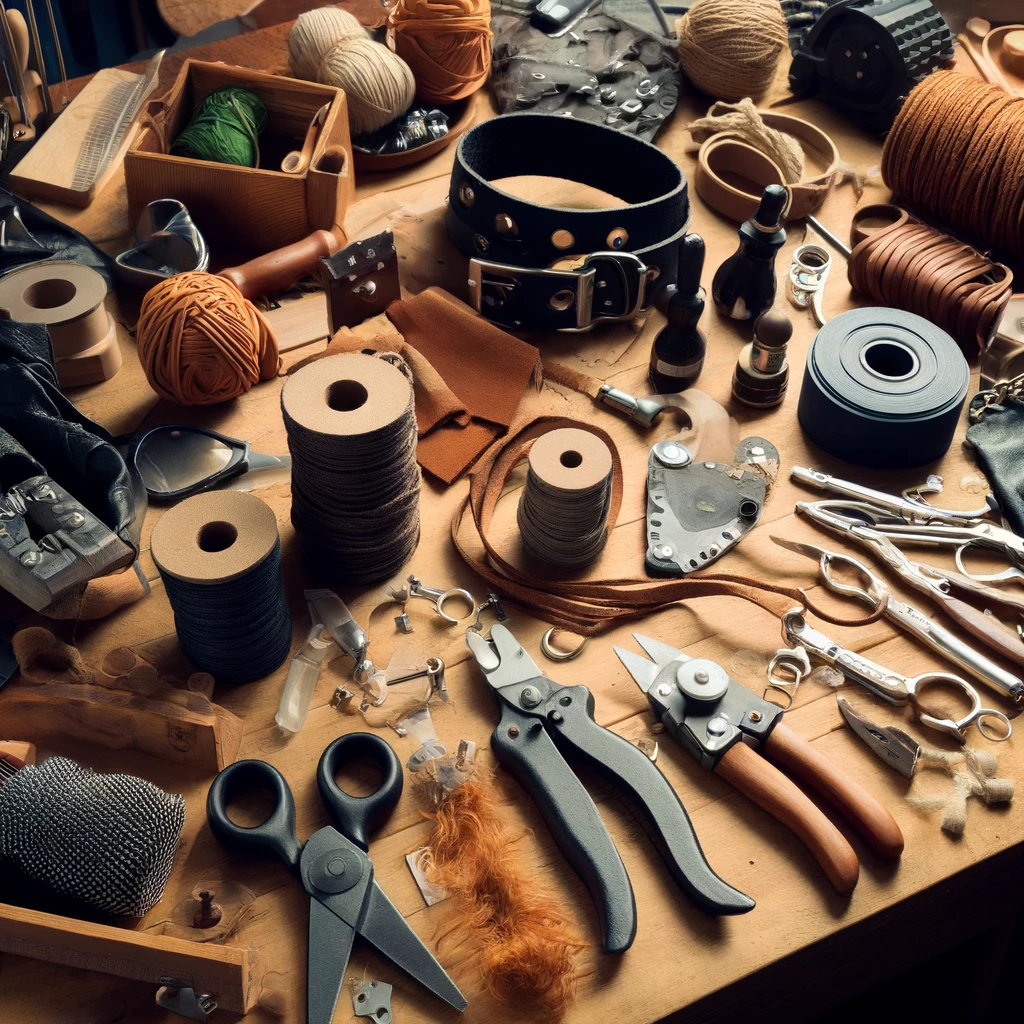Welcome to our comprehensive guide on DIY BDSM Gear Tutorials, where we delve into the art of crafting your personal BDSM playground. Creating your own BDSM gear not only allows for significant cost savings but also enables you to tailor your play to exactly suit your personal preferences and needs. In this blog, we’ll provide detailed tutorials and essential safety tips to help you safely personalise your BDSM experience.
1. Introduction to DIY BDSM Gear
The appeal of DIY in the BDSM community extends beyond cost-saving; it’s about customisation, creativity, and personal connection with the tools of your play. Whether you’re crafting restraints, paddles, or decorative pieces, making your own gear requires careful consideration, especially regarding the materials and design used.
2. Safety First: Materials and Construction

A detailed look at a hands-on DIY session where a custom leather cuff is meticulously assembled, showcasing the tools and materials involved in leatherworking.
Safety is paramount when it comes to creating BDSM gear. Always choose materials that are body-safe and non-allergenic. Avoid sharp edges, and ensure all fasteners are secure to prevent unintended injuries. Here are some material suggestions:
- Leather: Durable and comfortable, ideal for straps and cuffs.
- Wood: Great for paddles and canes, but must be sanded smooth and sealed.
- Rope: Cotton or silk rope is gentle on the skin and strong for bondage.
- Metal: Use for rings and buckles, ensuring they are smooth and free of rust.
3. DIY Tutorials
- Padded Leather Handcuffs
- Materials: Soft leather strips, foam padding, buckle, and rivets.
- Tools: Hole puncher, rivet gun, and scissors.
- Tutorial: Measure and cut the leather strips to fit your wrists comfortably. Sandwich the foam between two strips of leather for padding and secure the layers with rivets. Add a buckle for adjustments.
- Wooden Paddle
- Materials: Plywood or another solid wood, sandpaper, varnish.
- Tools: Saw, drill.
- Tutorial: Cut the wood into your desired shape. Sand the edges until smooth to avoid splinters. Finish with a coat of varnish to protect the wood and enhance its appearance.
- Rope Floggers
- Materials: Soft rope, a handle (wooden or metal).
- Tools: Scissors, lighter.
- Tutorial: Cut several lengths of rope, fold in half, and knot around the handle to secure them. Use a lighter to seal the ends of the rope to prevent fraying.

A detailed view of the DIY wooden paddle crafting process, showcasing various stages from raw cut wood to finished, sanded, and varnished paddles, along with essential tools on a rustic wooden table.
4. Testing and Maintenance
Once your DIY BDSM gear is ready, it’s crucial to test its strength and comfort in a safe, non-play environment first. Regular maintenance is also necessary to ensure the longevity and safety of your homemade items. Leather should be conditioned, wood varnished periodically, and metal inspected for rust.
5. Legal and Ethical Considerations
Always consider the legality of your creations, especially when modifying items that could be perceived as weapons. Additionally, consent and safe words are non-negotiable in every play session, even with trusted homemade gear.
6. Conclusion
DIY BDSM gear offers a wonderful opportunity to engage with your kinks on a deeper level, creating items that are perfectly suited to your desires. By following the tutorials and safety tips provided, you can enhance your BDSM experience while ensuring safety and saving money.
Engaging with DIY projects not only deepens your understanding of BDSM gear but also adds a personal touch to your play, making each session uniquely satisfying.




Your article helped me a lot, is there any more related content? Thanks!
Thank you so much for your kind words — I’m really glad you found the article helpful! 🙌
If you enjoyed this piece, you might also like our other DIY and safety-focused guides:
🔗 BDSM Safety Essentials: How to Play Smart and Stay Safe
🔗 Sensory Play: Exploring Touch, Temperature and Tease
🔗 Aftercare in BDSM: Why It Matters More Than You Think
We’re always adding new tutorials and community tips — you can also subscribe to our newsletter to get the latest updates straight to your inbox. 💌